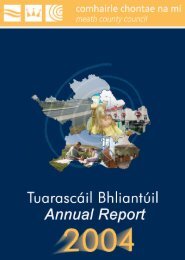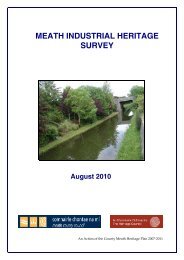Navan Points of Pride Brochure - Meath County Council
Navan Points of Pride Brochure - Meath County Council
Navan Points of Pride Brochure - Meath County Council
You also want an ePaper? Increase the reach of your titles
YUMPU automatically turns print PDFs into web optimized ePapers that Google loves.
5<br />
Continue up the hill and take a right turn onto the<br />
street named Timmons Hill. (‘Timmons’ is a family<br />
name, a prominent member that served as a town<br />
commissioner.) The street slopes down to the river.<br />
At the bottom <strong>of</strong> the hill, at the traffic lights, cross<br />
straight through the junction. You will be crossing<br />
the river Boyne on a bridge known as the New<br />
Bridge.<br />
Old Courthouse<br />
The Old Courthouse or Tholsel (now a solicitor’s premises) was erected in<br />
1632 by Edward Manning, who was both builder and architect. It is a slim,<br />
two-storey stone building noted for its three tall windows. The town stocks<br />
stood here in former times. The plaque bearing the date ‘1798’<br />
commemorates the United Irishmen who rebelled against English rule in<br />
May <strong>of</strong> that year. The <strong>of</strong>ficers <strong>of</strong> the <strong>Navan</strong> Cavalry, John Preston and Philip<br />
Barry, requested troops from Kells and met the insurgents, who were<br />
advancing towards <strong>Navan</strong>, on the Hill <strong>of</strong> Tara. The rebels’ pikes proved useless<br />
against trained soldiers and cannon, and the rebellion was easily crushed.<br />
In this area <strong>of</strong> the town the Corn Market was also located. The Town<br />
Corporation maintained a weighbridge in order to levy taxes on grain<br />
entering the town to be traded and shipped on to the port <strong>of</strong> Drogheda.<br />
The New Bridge<br />
Built in 1756, the ‘New’ Bridge was the first to connect the town <strong>of</strong> <strong>Navan</strong><br />
to the east side <strong>of</strong> the Boyne. Before that, to cross the river without getting<br />
wet, you had to travel 3km east to the 15th century bridge, (which still<br />
survives at Kilcarn), or 5km north to Babes Bridge, where just two pillars<br />
remain.<br />
Cross the bridge, continue on this road and take the next<br />
right, just before the <strong>Navan</strong> Education Centre which is on the<br />
right, at the signpost for Athlumney. Continue up this road.




